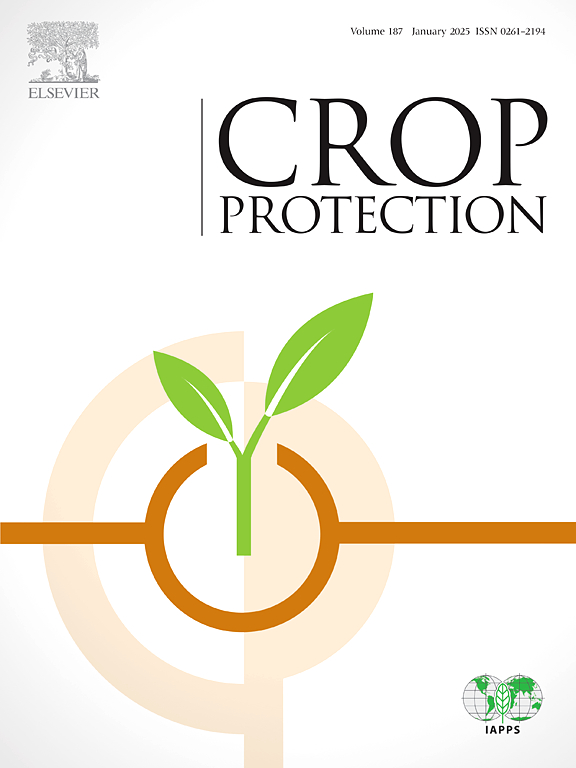Theresimima ampellophaga (Bayle-Barelle 1809) (Lepidoptera, Zygaenidae, Procridinae): Past, present, and future of an overlooked vine pest
IF 2.5
2区 农林科学
Q1 AGRONOMY
引用次数: 0
Abstract
Research on vineyard pests is crucial for the reduction of annual yield losses and the development of sustainable methods of pest control. The vine-bud moth, Theresimima ampellophaga, has long been considered a harmful grapevine pest in the countries bordering the Mediterranean basin. The larvae feed extensively on vine leaves and buds, and records from the early 20th century indicate that even a minor infestation could halve a vine's total productivity. Despite this, it has received limited scientific attention in recent years, with limited updated information on its biology, ecology, and pest activity. Herein, we conducted a systematic literature review to consolidate all available data about the vine-bud moth into a single body of work. The gathered data revealed that this insect may not currently be as widespread and detrimental to modern vineyards as their historical reputation indicates. However, the vine-bud moth should also not be underestimated or overlooked, as its pest status is prone to evolve as climate changes. There is still a possibility that it could revert to being a major pest in the future, as factors like environmental resilience, trophic dominance and phenology are modified. We recommend a thorough reassessment of the currently available knowledge on this species to fill in knowledge gaps and clarify existing uncertainties. Additionally, there is much scope for further studies on this insect, especially in the fields of phylogenetics and behavioral ecology.
食蚜螨(Bayle-Barelle 1809)(鳞翅目,鲜蝇科,原蝇科):一种被忽视的葡萄害虫的过去、现在和未来
对葡萄园有害生物的研究对于减少年产量损失和开发可持续的害虫防治方法至关重要。葡萄芽蛾(Theresimima ampellophaga)长期以来一直被认为是地中海盆地沿岸国家葡萄藤的有害害虫。这种幼虫以藤蔓的叶子和芽为食,20世纪初的记录表明,即使是轻微的侵染也会使藤蔓的总产量减半。尽管如此,近年来它受到的科学关注有限,关于它的生物学、生态学和害虫活动的最新信息有限。在此,我们进行了系统的文献综述,将所有关于藤芽蛾的可用数据整合到一个单一的工作中。收集到的数据显示,这种昆虫目前对现代葡萄园的危害可能并不像它们历史上的名声所表明的那样广泛和有害。然而,藤芽蛾也不应该被低估或忽视,因为它的害虫状态很容易随着气候变化而变化。随着环境恢复力、营养优势和物候等因素的改变,它仍有可能在未来恢复为主要害虫。我们建议对该物种现有的知识进行彻底的重新评估,以填补知识空白并澄清现有的不确定性。此外,对这种昆虫的进一步研究,特别是在系统发育和行为生态学方面还有很大的空间。
本文章由计算机程序翻译,如有差异,请以英文原文为准。
求助全文
约1分钟内获得全文
求助全文
来源期刊

Crop Protection
农林科学-农艺学
CiteScore
6.10
自引率
3.60%
发文量
200
审稿时长
29 days
期刊介绍:
The Editors of Crop Protection especially welcome papers describing an interdisciplinary approach showing how different control strategies can be integrated into practical pest management programs, covering high and low input agricultural systems worldwide. Crop Protection particularly emphasizes the practical aspects of control in the field and for protected crops, and includes work which may lead in the near future to more effective control. The journal does not duplicate the many existing excellent biological science journals, which deal mainly with the more fundamental aspects of plant pathology, applied zoology and weed science. Crop Protection covers all practical aspects of pest, disease and weed control, including the following topics:
-Abiotic damage-
Agronomic control methods-
Assessment of pest and disease damage-
Molecular methods for the detection and assessment of pests and diseases-
Biological control-
Biorational pesticides-
Control of animal pests of world crops-
Control of diseases of crop plants caused by microorganisms-
Control of weeds and integrated management-
Economic considerations-
Effects of plant growth regulators-
Environmental benefits of reduced pesticide use-
Environmental effects of pesticides-
Epidemiology of pests and diseases in relation to control-
GM Crops, and genetic engineering applications-
Importance and control of postharvest crop losses-
Integrated control-
Interrelationships and compatibility among different control strategies-
Invasive species as they relate to implications for crop protection-
Pesticide application methods-
Pest management-
Phytobiomes for pest and disease control-
Resistance management-
Sampling and monitoring schemes for diseases, nematodes, pests and weeds.
 求助内容:
求助内容: 应助结果提醒方式:
应助结果提醒方式:


